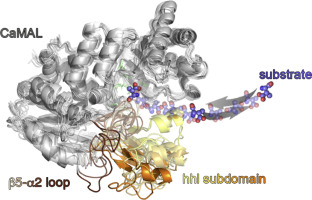当前位置:
X-MOL 学术
›
BBA Gen. Subj.
›
论文详情
Our official English website, www.x-mol.net, welcomes your
feedback! (Note: you will need to create a separate account there.)
The antimicrobial peptide Temporin L impairs E. coli cell division by interacting with FtsZ and the divisome complex.
Biochimica et Biophysica Acta (BBA) - General Subjects ( IF 2.8 ) Pub Date : 2020-03-27 , DOI: 10.1016/j.bbagen.2020.129606 Angela Di Somma 1 , Concetta Avitabile 2 , Arianna Cirillo 3 , Antonio Moretta 4 , Antonello Merlino 3 , Luigi Paduano 3 , Angela Duilio 3 , Alessandra Romanelli 5
Biochimica et Biophysica Acta (BBA) - General Subjects ( IF 2.8 ) Pub Date : 2020-03-27 , DOI: 10.1016/j.bbagen.2020.129606 Angela Di Somma 1 , Concetta Avitabile 2 , Arianna Cirillo 3 , Antonio Moretta 4 , Antonello Merlino 3 , Luigi Paduano 3 , Angela Duilio 3 , Alessandra Romanelli 5
Affiliation

|
BACKGROUND
The comprehension of the mechanism of action of antimicrobial peptides is fundamental for the design of new antibiotics. Studies performed looking at the interaction of peptides with bacterial cells offer a faithful picture of what really happens in nature.
METHODS
In this work we focused on the interaction of the peptide Temporin L with E. coli cells, using a variety of biochemical and biophysical techniques that include: functional proteomics, docking, optical microscopy, TEM, DLS, SANS, fluorescence.
RESULTS
We identified bacterial proteins specifically interacting with the peptides that belong to the divisome machinery; our data suggest that the GTPase FtsZ is the specific peptide target. Docking experiments supported the FtsZ-TL interaction; binding and enzymatic assays using recombinant FtsZ confirmed this hypothesis and revealed a competitive inhibition mechanism. Optical microscopy and TEM measurements demonstrated that, upon incubation with the peptide, bacterial cells are unable to divide forming long necklace-like cell filaments. Dynamic light scattering studies and Small Angle Neutron Scattering experiments performed on treated and untreated bacterial cells, indicated a change at the nanoscale level of the bacterial membrane.
CONCLUSIONS
The peptide temporin L acts by a non-membrane-lytic mechanism of action, inhibiting the divisome machinery.
GENERAL SIGNIFICANCE
Identification of targets of antimicrobial peptides is pivotal to the tailored design of new antimicrobials.
中文翻译:

抗菌肽 Temporin L 通过与 FtsZ 和分裂体复合物相互作用损害大肠杆菌细胞分裂。
背景了解抗菌肽的作用机制是设计新抗生素的基础。观察肽与细菌细胞相互作用的研究提供了自然界真实情况的真实画面。方法 在这项工作中,我们专注于肽 Temporin L 与大肠杆菌细胞的相互作用,使用各种生化和生物物理技术,包括:功能蛋白质组学、对接、光学显微镜、TEM、DLS、SANS、荧光。结果 我们确定了与属于分裂体机制的肽特异性相互作用的细菌蛋白。我们的数据表明 GTPase FtsZ 是特定的肽靶标。对接实验支持 FtsZ-TL 交互;使用重组 FtsZ 的结合和酶促测定证实了这一假设并揭示了竞争性抑制机制。光学显微镜和 TEM 测量表明,在与肽一起孵育后,细菌细胞无法分裂形成长项链状细胞丝。在处理和未处理的细菌细胞上进行的动态光散射研究和小角中子散射实验表明细菌膜的纳米级水平发生了变化。结论 temporin L 肽通过非膜溶解机制发挥作用,抑制分裂机制。一般意义 抗菌肽靶点的鉴定对于新抗菌剂的定制设计至关重要。与肽一起孵育后,细菌细胞无法分裂形成长项链状细胞丝。在处理和未处理的细菌细胞上进行的动态光散射研究和小角中子散射实验表明细菌膜的纳米级水平发生了变化。结论 temporin L 肽通过非膜溶解机制发挥作用,抑制分裂机制。一般意义 抗菌肽靶点的鉴定对于新抗菌剂的定制设计至关重要。与肽一起孵育后,细菌细胞无法分裂形成长项链状细胞丝。在处理和未处理的细菌细胞上进行的动态光散射研究和小角中子散射实验表明细菌膜的纳米级水平发生了变化。结论 temporin L 肽通过非膜溶解机制发挥作用,抑制分裂机制。一般意义 抗菌肽靶点的鉴定对于新抗菌剂的定制设计至关重要。表明细菌膜的纳米级水平发生了变化。结论 temporin L 肽通过非膜溶解机制发挥作用,抑制分裂机制。一般意义 抗菌肽靶点的鉴定对于新抗菌剂的定制设计至关重要。表明细菌膜的纳米级水平发生了变化。结论 temporin L 肽通过非膜溶解机制发挥作用,抑制分裂机制。一般意义 抗菌肽靶点的鉴定对于新抗菌剂的定制设计至关重要。
更新日期:2020-03-28
中文翻译:

抗菌肽 Temporin L 通过与 FtsZ 和分裂体复合物相互作用损害大肠杆菌细胞分裂。
背景了解抗菌肽的作用机制是设计新抗生素的基础。观察肽与细菌细胞相互作用的研究提供了自然界真实情况的真实画面。方法 在这项工作中,我们专注于肽 Temporin L 与大肠杆菌细胞的相互作用,使用各种生化和生物物理技术,包括:功能蛋白质组学、对接、光学显微镜、TEM、DLS、SANS、荧光。结果 我们确定了与属于分裂体机制的肽特异性相互作用的细菌蛋白。我们的数据表明 GTPase FtsZ 是特定的肽靶标。对接实验支持 FtsZ-TL 交互;使用重组 FtsZ 的结合和酶促测定证实了这一假设并揭示了竞争性抑制机制。光学显微镜和 TEM 测量表明,在与肽一起孵育后,细菌细胞无法分裂形成长项链状细胞丝。在处理和未处理的细菌细胞上进行的动态光散射研究和小角中子散射实验表明细菌膜的纳米级水平发生了变化。结论 temporin L 肽通过非膜溶解机制发挥作用,抑制分裂机制。一般意义 抗菌肽靶点的鉴定对于新抗菌剂的定制设计至关重要。与肽一起孵育后,细菌细胞无法分裂形成长项链状细胞丝。在处理和未处理的细菌细胞上进行的动态光散射研究和小角中子散射实验表明细菌膜的纳米级水平发生了变化。结论 temporin L 肽通过非膜溶解机制发挥作用,抑制分裂机制。一般意义 抗菌肽靶点的鉴定对于新抗菌剂的定制设计至关重要。与肽一起孵育后,细菌细胞无法分裂形成长项链状细胞丝。在处理和未处理的细菌细胞上进行的动态光散射研究和小角中子散射实验表明细菌膜的纳米级水平发生了变化。结论 temporin L 肽通过非膜溶解机制发挥作用,抑制分裂机制。一般意义 抗菌肽靶点的鉴定对于新抗菌剂的定制设计至关重要。表明细菌膜的纳米级水平发生了变化。结论 temporin L 肽通过非膜溶解机制发挥作用,抑制分裂机制。一般意义 抗菌肽靶点的鉴定对于新抗菌剂的定制设计至关重要。表明细菌膜的纳米级水平发生了变化。结论 temporin L 肽通过非膜溶解机制发挥作用,抑制分裂机制。一般意义 抗菌肽靶点的鉴定对于新抗菌剂的定制设计至关重要。











































 京公网安备 11010802027423号
京公网安备 11010802027423号